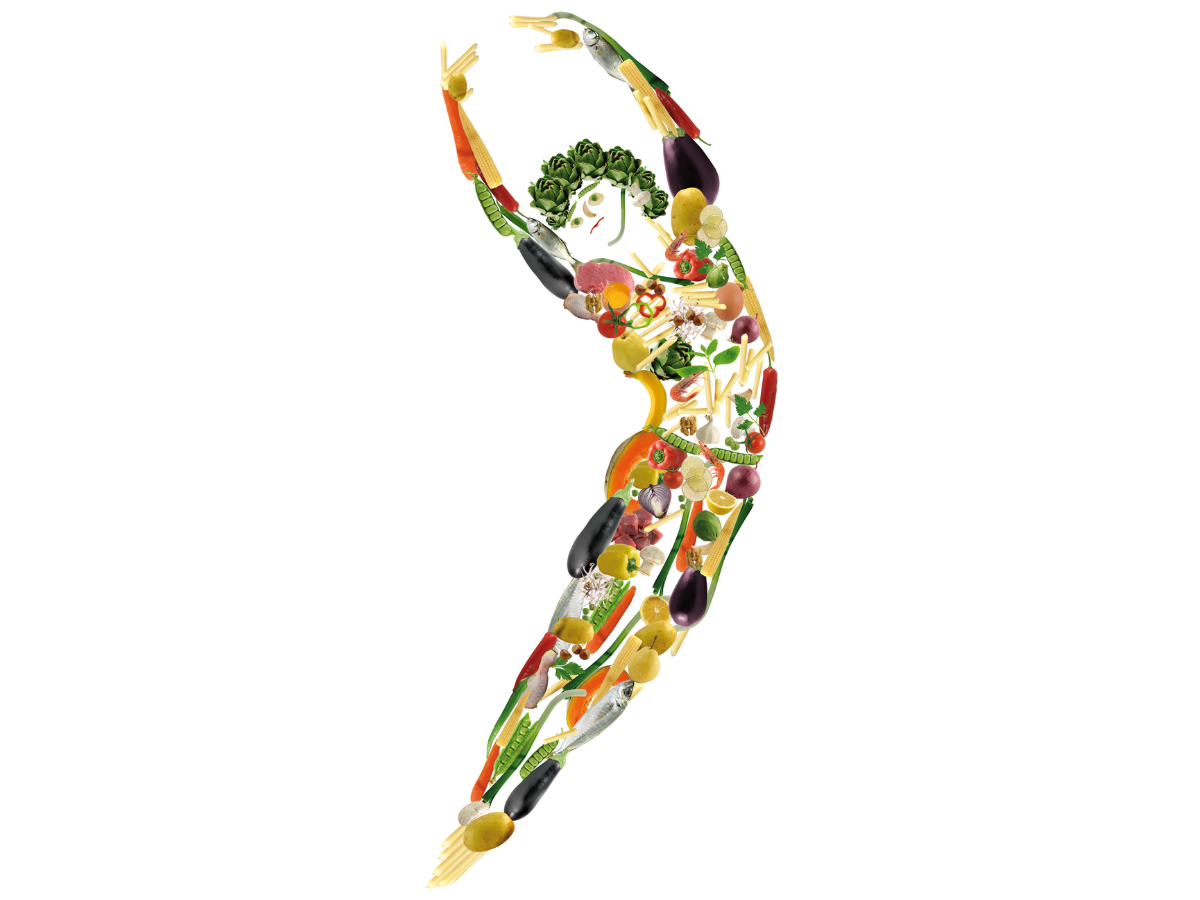L'alimentation est l'un des piliers fondamentaux de notre santé et de notre bien-être.
Au-delà du maintien d’un poids d’équilibre, il est extrêmement important de se nourrir sainement pour être et rester en bonne santé : rappelez-vous de la citation d’Hippocrate "Que ton alimentation soit ta première médecine" dont nous parlions dans un précédent article !
Cependant il existe une multitude de régimes alimentaires aujourd'hui, certains ayant des effets plus délétères que bénéfiques. C’est le cas notamment de beaucoup de régimes restrictifs qui imposent des privations de certains groupes d’aliments. Ils peuvent de ce fait conduire à des carences nutritionnelles, à des troubles alimentaires, à une perte de masse musculaire et à une diminution d'énergie. Les régimes restrictifs peuvent également entraîner un sentiment de culpabilité vis à vis de la nourriture et une perte de plaisir à manger.

Il est donc préférable d'adopter une alimentation équilibrée et variée à long terme afin d’apporter à notre corps tous les nutriments nécessaires et limiter les risques de troubles du comportement alimentaire.
Pour cela plusieurs régimes non restrictifs existent, nous permettant de manger de tout en quantités raisonnables, tout en respectant les principes d'une alimentation saine.
Dans cet article, nous allons décrire plusieurs façon de s’alimenter sainement et sans restrictions drastiques : le régime Shelton (ou dissocié), le régime Seignalet et la Chrononutrition, avant de passer en revue les recommandations de Marchesseau.
Le régime Shelton (ou dissocié)

Le régime Shelton dissocié, ou régime dissocié, est une approche alimentaire qui préconise de ne pas combiner certains groupes d'aliments lors des repas.
Les aliments sont alors consommés selon des combinaisons précises dans le but de respecter les capacités biologiques d’assimilation des nutriments tout en respectant les temps de digestion.
L'idée est que certains aliments forment une mauvaise association lorsqu'ils sont consommés ensemble et interfèrent avec la digestion, entraînant une digestion incomplète, une fermentation, une production accrue de gaz et d'autres problèmes digestifs. Par ailleurs, en ingérant uniquement des catégories d’aliments similaires de manière simultanée, l’énergie dépensée pour la digestion et l’assimilation des nutriments est moindre, ce qui laisse plus d’énergie disponible pour les autres activités physiques et intellectuelles.
Voici quelques principes clés du régime Shelton dissocié :
1 - Séparer les protéines et les féculents : Selon ce régime, il est recommandé de ne pas consommer des protéines (comme la viande, le poisson, les œufs) et des féculents au même repas (comme le pain, les pâtes, les pommes de terre).
2 - Le régime Shelton dissocié suggère également d'éviter les repas qui combinent plusieurs types de protéines ou plusieurs types de glucides. Par exemple, il est recommandé de ne pas manger de la viande et du poisson lors d'un même repas, ou de ne pas mélanger des féculents différents comme le riz et les pâtes.
3 - Manger les fruits séparément : Selon cette approche, les fruits devraient être consommés seuls, entre les repas (voire en début de repas), et ne devraient pas être mélangés avec d'autres aliments pour éviter la fermentation dans l’estomac (ils sont digérés beaucoup plus vite que les autres aliments).
4 - Respecter les intervalles entre les repas : Le régime Shelton dissocié préconise de laisser un intervalle de temps suffisant entre les différents repas. Il est recommandé de ne pas prendre un nouveau repas tant que le précédent n'est pas complètement digéré.
Le but de ce régime est avant tout l’amélioration de la digestion et un mieux-être général.
Le régime Seignalet (appelé également régime hypotoxique ou ancestral)

Ce régime a été développé dans le but de soulager les symptômes de certaines maladies auto-immunes et inflammatoires (polyarthrite rhumatoïde, maladie de Crohn...) en revenant à une alimentation ancestrale, originelle et hypotoxique. Selon le Dr. Jean Seignalet, les nombreuses transformations moléculaires subies par les aliments que nous consommons (OGM…), ont rendu certains d’entre eux toxiques pour l’organisme.
Voici les principes fondamentaux de ce régime :
1 - Éviter les aliments inflammatoires : Cela comprend les céréales dites “modernes”, notamment celles contenant du gluten (blé, seigle, orge, mais aussi maïs…), les produits laitiers, hautement sensibilisants pour les adultes, les aliments industriels transformés (y compris les sucres raffinés) contenant des additifs, des conservateurs et des ingrédients artificiels, et les huiles riches en oméga-6 (comme l'huile de tournesol).
2 - Miser sur les aliments frais et naturels, au maximum bios : Le régime Seignalet met l'accent sur les aliments non transformés, riches en nutriments et faciles à digérer. Il recommande de consommer des légumes, des fruits, des viandes maigres, du poisson, des œufs, des noix, des graines, des huiles d'olive et de colza, ainsi que des céréales peu transformées telles que le riz, le quinoa et le sarrasin.
3 - Favoriser la cuisson douce : Le Dr Seignalet préconise une cuisson basse température des aliments, comme la cuisson à la vapeur, afin de préserver au maximum les nutriments et d'éviter la formation de substances potentiellement toxiques.
4 - Individualiser l'alimentation : Le régime Seignalet met l'accent sur l'individualisation de l'alimentation en fonction des intolérances et des sensibilités de chaque personne. Il encourage l'observation des réactions individuelles aux aliments et la personnalisation du régime en conséquence. La Chrononutrition

Le principe de la Chrononutrition repose sur l'idée que notre corps suit des rythmes biologiques naturels, appelés rythmes circadiens, qui régulent de nombreux processus physiologiques, et que l’alimentation doit être adaptée à ces rythmes. Les apports nutritionnels doivent être organisés selon les besoins de l’organisme tout au long de la journée. Aucun aliment n'est interdit, mais il faut consommer les groupes d'aliments adaptés au bon moment.
Voici les différents principes de la Chrononutrition :
1 - Adapter son alimentation aux différents moments de la journée : il est conseillé de consommer des aliments riches en graisses et en protéines le matin pour apporter de l'énergie, des protéines et des féculents au déjeuner pour favoriser la satiété, une collation sucrée en milieu d’après-midi (avec de “bons sucres”: fruits secs, chocolat noir…) et des aliments légers et faciles à digérer le soir (protéines maigres, légumes…).
2 - Manger lentement et mastiquer : La Chrononutrition met l'accent sur une alimentation consciente, en prenant le temps de manger lentement et de bien mastiquer les aliments. Cela favorise une meilleure digestion et une meilleure assimilation des nutriments.
3 - Éviter les grignotages : La Chrononutrition recommande de limiter les grignotages entre les repas, car cela peut perturber les rythmes biologiques et favoriser une prise de poids. Il est préférable de respecter des horaires de repas réguliers.
4 - Adapter l'alimentation à l'activité physique : La Chrononutrition recommande d'adapter son alimentation à son niveau d'activité physique. Par exemple, il est conseillé de consommer des aliments riches en glucides avant une activité intense pour fournir de l'énergie, et des aliments riches en protéines après l'effort pour favoriser la récupération musculaire.
5 - Boire suffisamment d'eau : La Chrononutrition souligne l'importance de l'hydratation. Il est recommandé de boire de l'eau régulièrement tout au long de la journée pour maintenir une bonne hydratation.
L’alimentation selon Marchesseau

Pierre-Valentin Marchesseau est considéré comme l'un des pionniers de la naturopathie en France. Il était connu pour promouvoir une approche holistique de la santé, mettant l'accent sur les principes naturels de guérison et le respect de l'équilibre du corps.
L’hygiène alimentaire enseignée par Marchesseau doit être individualisée : nous sommes tous différents.
Il recommande également de ne pas s’éloigner de l’alimentation physiologique de chaque espèce : notre système digestif est adapté à une alimentation spécifique, et si cette alimentation est dénaturée, nous dépérissons.
Selon Marchesseau, l’homme a système digestif proche de celui des singes anthropoïdes, et comme eux nous sommes faits pour manger en grande majorité des produits végétaux, de préférence crus et bio (80% de notre alimentation). Environ 15% de notre alimentation doit être réservée aux produits animaux (coquillages, oeufs, laitages crus…), et les 5% restants aux glucides et légumineuses.
L’ensemble des recommandations alimentaires passées en revue dans cet article, qui sont d’ailleurs assez complémentaires, permettent de s’alimenter de façon saine et équilibrée en permettant à l’organisme d’avoir tous les apports nécessaires à son bon fonctionnement.
Il est à noter toutefois qu’avant d'adopter un régime spécifique, même non-restrictif, il est conseillé de consulter un professionnel de santé ou un nutritionniste pour obtenir des conseils adaptés à vos besoins individuels.

